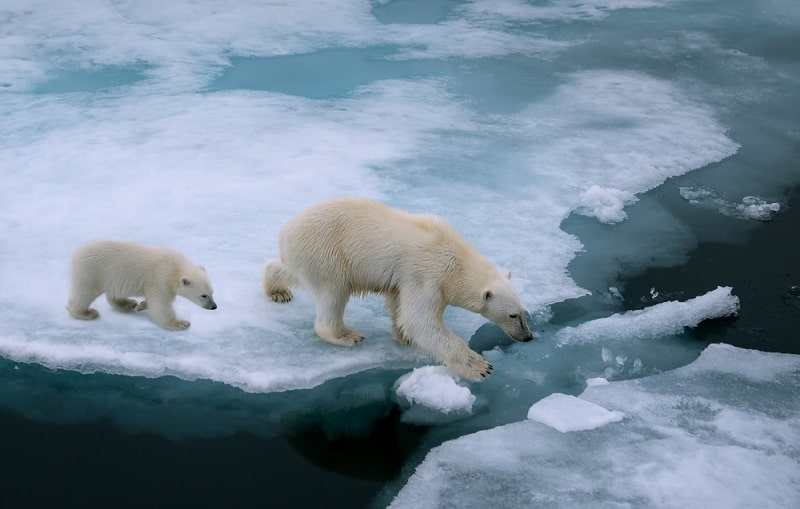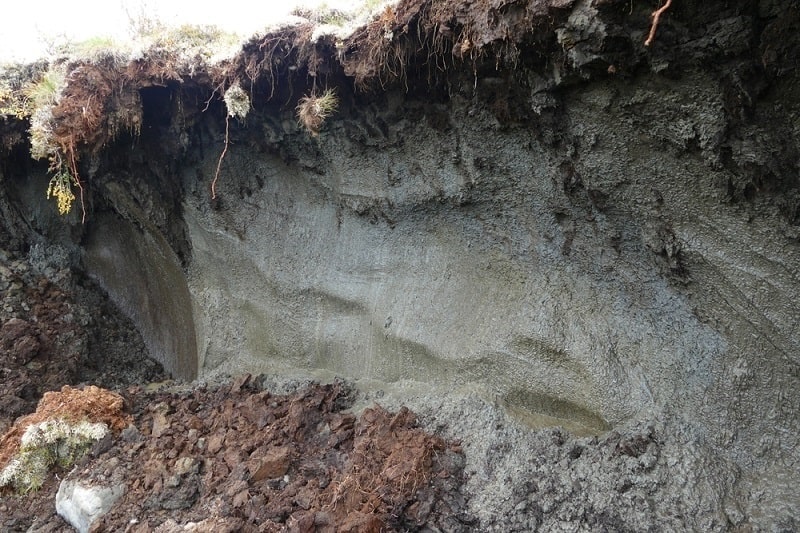Global warming is a hot-button issue for some people. Most agree that humans have contributed to the problem, but some still hold back their judgment.
No one is arguing, however, that global temperatures are not rising. They are, and arctic animals are on the frontlines of these changes. Ahead, we’ll take a look at six ways global warming is harming these arctic animals.
Polar Bears
Polar bears are at the top of the arctic food chain, which means they feel both direct and indirect effects of global warming. Being an arctic predator means putting polar bears at a heightened risk of extinction. They rely on the other arctic animals as food sources, but these animals are also being harmed by the uptick in global temperatures.
Here are some of the ways that polar bears are feeling the effects of global warming.
Polar Bear Reproduction
The reproduction of polar bears – and thus their ability to survive as a species – is under direct attack from the rising temperatures of their environment. One of the biggest ways the species see this effect is in their reproduction abilities.
Pregnant female polar bears will build their winter dens in areas with thick snow and ice cover – which are becoming rarer as time goes on. They won’t emerge from their dens until the spring, which means fasting for six months or so at a time.
The change to the climate in the area has put an even longer timer on when these mothers can leave the den with their cubs. Now, polar bears will have to wait even longer to emerge, which means less food for them and their cubs.
Polar bear reproduction has a direct correlation with their fat stores. Their litter size and weight will suffer when there isn’t enough food, or if they have to stay in their den for longer than they have throughout their history.
When they finally emerge, there isn’t enough food as there used to be. One of the places where this effect is most evident is in places like James and Hudson Bays in Canada. The weight and number of cubs from polar bears in Hudson bay decreased by 15% from 1981 to 1998 alone (key finding 4), and the global temperatures aren’t getting any cooler.
Loss of Habitat: Polar Bears
The increased global temperatures are directly contributing the polar bear deaths through their loss of habitat. These bears rely on sea ice and will need to find a new place to live, feed, and reproduce as the ice begins to melt.
The changes in the environment also directly lead to an increased number of polar bear mother and cub deaths. Spring rains have been heavier and more frequent in the Arctic, and this can often lead to dens collapsing and killing or stranding the polar bears within.
The remaining polar bears in the Arctic will have to travel south as the ice continues to melt and polar bears lose more of their habitat. This puts them at risk as they compete for the same food supply as other bears and come in more frequent contact with humans.
Food Poisoning
Since polar bears are at the top of the arctic food chain, they are affected by all of the contaminants that other arctic animals eat. Seals – in particular – often come in contact with marine contaminants throughout their life.
Polar bears absorb these contaminants when they eat their prey, and will eventually store the contaminants in their fat. This isn’t too much of a problem when the bears are constantly feeding since the fat storage doesn’t harm polar bear health.
Unfortunately, the food supply for polar bears and other arctic animals is drying up, which means these bears have to fast for longer. They rely on their fat storage, which they burn for energy.
When there are chemicals in the fat, however, it can harm a polar bear’s health – even leading to their death (key finding 4).
A Loss Of Habitat For All Arctic Animals
Of course, polar bears aren’t the only arctic animals losing their habitats due to changing global temperatures. Walruses, seals, seabirds, and other arctic animals rely on the ice to survive and thrive and are losing ground every single year.
Seals
Seals use the ice for breeding during the season and resting in the spring. They also search for food near and under the ice. Some species of seals rely on the ice more than others.
Ringed seals, for instance, use the ice as cover in the winter and a place to rear their young when it’s time to breed. Melting ice means that mothers might be separated from their pups, lowering the survival rate of the species as a whole.
Sea Birds
You might not realize it, but many of the birds in the Arctic rely on the ice for survival as well. Many of these birds use the ice as protection against predators. They perch on high cliffs and fish through holes in the ice. The melting ice has already begun affecting these birds, substantially reducing their overall population
Walruses
Walruses are particularly vulnerable to melting arctic ice since they rely on the ice edge for resting and feeding purposes. The ice edge is the first to shrink due to climate change, which can put many of the walruses in the area at severe risk.
These walruses need someplace to rest, and a retreating ice edge means they have to travel further to do so. The travel alone – along with the new areas they’re entering – puts them at extreme risk of starvation and death.
Warmer Temperatures – More Sun Absorption
Another global warming element that affects all kinds of arctic animals is the rising temperatures. The loss of ice in the Arctic creates a vicious cycle – as we’ll cover briefly below. Not only are many of these arctic animals losing their habitats, but the water and land are becoming warmer nearly every year.
The land and ocean in the Arctic are now absorbing more sunlight than ever, which means it’s warming up. This warming will harm the local animals and fish, but will also open the door for further manipulation of the ecosystem.
Trade routes, drilling, and the like don’t travel through the Arctic, but warming temperatures and fewer hazards mean they may start. Increased human interaction will only accelerate the problem, leading to more extinction and endangerment of the animals in the Arctic.
The Food Chain Disruption
A local food chain requires all animals within the chain to have an ample amount of food. If one key element of the food chain goes missing, animals will need to adapt to survive – something that isn’t always possible.
Grasses, mosses, and other sources of food that prey animals eat are becoming more difficult to find due to climate change. When small and large plant animals can’t find food, they begin to die out or move. This makes it more difficult to find prey animals for predators, which in turn makes their populations suffer.
Global warming is drastically affecting the food chain in the Arctic. These food sources are still there – for now – but if these trends continue, they won’t be for too much longer. Once this happens, the Arctic will no longer support the wildlife that currently calls it home.
A Dangerous Cycle
Global warming and melting ice go hand-in-hand. Some people don’t realize how problematic losing ice can be for the environment. The more ice we lose, the higher the sea level becomes. At the same time, the ice won’t reflect as much sunlight as it once did.
The ultimate result is that the planet becomes warmer. The warmer the planet becomes, the more ice will melt. As you can see, this is a dangerous cycle that is only speeding up as time goes on.
Increased pollution also adds to the problem. Some of the ice in the Arctic becomes dark from the pollution in the air. The dark top layer of ice absorbs the sun at a faster rate, which further accelerates melting and subsequently global warming.
A Path Forward
It’s easy to take an “out of sight, out of mind” approach when it comes to global warming. The animals we included in this article are on the frontlines of climate change and feel the direct effect of the choices humans make half a world away.
Although you have probably never visited these locations, the safety and wellbeing of these animals show the future we may soon face. A loss of habitat for them means an eventual loss of habitat for ourselves if we aren’t careful.
All we can do as humans are consciously move forward. We can limit our personal carbon footprints, and vote for legislation that helps limit the problems we’ve already caused on this planet.
This problem is not localized to the Arctic. People around the globe are already feeling the harsh effects of climate change, and we need to change our ways if we want to continue to live on this planet.
-
Geoengineering proposes climate change solutions by deliberate and large-scale human intervention in the Earth’s natural…
-
The Arctic Shelf. Areas on our planet are defined by extremes. They represent the harsh…
-
Some people have proposed carbon sequestration as a solution to global climate change. But what…
-
Although disproved, the notion of a “climate change hiatus” is one that perpetuates in the…
-
You probably read about permafrost once upon a time in a high school or college…
-
Following a stormy winter, temperature influx, and weather patterns consistent with climate change, the Bering…





